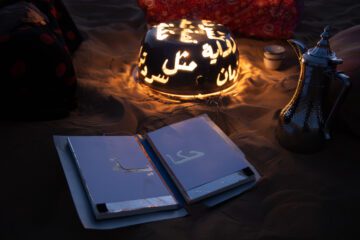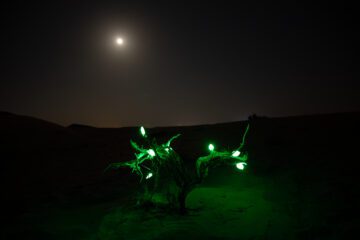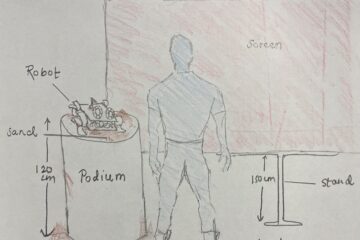Link to slides: https://docs.google.com/presentation/d/1XLyADLfZ41WpfqKDgqbmwdNZ7qKAmnp8FmRsA9akTfY/edit?usp=sharing
Project Theme and Main Idea
The Emirati people of the past not only lived but thrived and built communities in the desert. As such, it is hard to accept the notion or popular stereotype of the desert being an isolated, scary, and mysterious place. So, we wanted our project to communicate this sense of the desert being a place of community, family, gathering, and interaction amongst people.
The “حكايـــــة” Beacon is an interactive device designed to symbolize the history and vibrancy of desert communities. Drawing inspiration from traditional desert gatherings and the spirit of communication, this device serves not only as an emblem of desert unity but also as a functional tool to bridge connections among people.
We hope to create a battery-powered beacon that emits a soft, warm glow, just like a campfire, inviting people to gather around. As individuals come closer, the device detects their presence, triggering the playback of pre-recorded stories, poems, and songs from UAE’s rich oral tradition.
Existing Projects and Inspirations

Naturally, the main source of inspiration for our project is the historical emphasis on oral storytelling throughout Emirati society. Indigenous Emirati tribes and families would pass down stories, folktales, and poems through their native language which would nowadays inform and educate us about their lives [1]. Very early on, “the written word traditionally took second place to listening to stories”[1]. Bedu would form stories mainly about life in the desert, given that survival and prosperity was the main priority[2]. Their life experiences served as a form of social learning, allowing the following generation to advance further using that knowledge[2]. The UAE today is actively investing into the preservation of such cultural history through theater, museum material and archives, but many of the stories either remain lost or untold due to drastic changes in the dialect between tribes and the lack of written records[2][3]. We hope that through crowdsourcing and accessing multiple records, our installation will preserve and echo the voices of generations who thrived and shaped Emirati traditions and stories in the desert landscape.
A big source of inspiration that would facilitate our efforts in collecting stories is the book on Emirati accounts and stories by the Emirati writer group ‘The Knot’. In this book, The Knot collected oral recounts of fond memories of accredited Emirati adults and elders, documenting their life in the UAE involving family, traditions, and celebrations.
The design we will be implementing is inspired by eL Seed’s “Mirage”[4], where we will be creating the same hemispherical dome shape with cutouts of arabic calligraphy. The calligraphy on eL Seed’s installations reflects poetry written in appreciation of the region, celebrating its rich history through written art [4]. Similarly, our project aims to appreciate the broader desert landscape and its attachment to Emirati culture and traditions.
Another source of inspiration for the design will be record players and their rotational element. We envision the dome rotating synchronically with the recorded audios to imitate a record player but also act as a visual signal that is familiar and self-explanatory to unsuspecting wanderers.
[1] Hameli, Asmaa Al. “The Stories That Bring the Nation’s History to Life.” The National, February 10, 2014. https://www.thenationalnews.com/uae/the-stories-that-bring-the-nation-s-history-to-life-1.284572.
[2] Rainey, Elizabeth. “The Art of Storytelling in Bedouin Society: A 21st-Century Ethnographic Collection of Poems from the United Arab Emirates.” Material Culture Review, 2015. https://journals.lib.unb.ca/index.php/MCR/article/view/25624.
[3] “Storytelling Plays Vital Role in Emirati Society – GulfToday.” Accessed November 6, 2023. https://www.gulftoday.ae/news/2019/04/28/storytelling-plays-vital-role-in-emirati-society.
[4] “Desert X | eL Seed.” Accessed November 6, 2023. https://desertx.org/dx/desert-x-alula-2020/el-seed.
Sketches and Mechanics

Motion sensor → Our project is designed to capture the essence of Emirati desert night gatherings. Instead of relying on a light sensor, we chose a motion sensor. This decision was made based on the fact that a motion sensor performs better in low-light conditions, and its ability to activate the lights when people approach adds an intriguing element that encourages exploration and engagement.
Touch sensor → In order to encourage more engagement and interactivity with the project piece, we decided to use a touch sensor in order to trigger the audio. This way, we are both encouraging the audience to get closer to the piece to explore it and also stay where they are to listen to the audio.
Buttons → To give the audience the liberty of choosing what they would like to hear, we are thinking of adding two buttons to the project: one to replay the audio and another to change to the next audio. – The audio: has a sound system inside the enclosure and the audio goes from a story → poem → song and so on.
360 servo motor + lazy susan mechanism → To illuminate the calligraphy and lights in a captivating way on the sand and dunes, resembling a bonfire, we decided that incorporating a 360 servo motor and a lazy susan mechanism would be the most suitable choice for achieving our vision.
3D printing will be used for the enclosure dome and inner dome system that would add aesthetic value while also functioning as a protective layer over the hardware from the sand and desert environment.
Sketches and Mechanics
To start off, we will begin by breaking down the mechanics of our project and decide on how exactly we’ll be achieving each mechanism and combining them all together. Below is a rough timeline of this process:
- Break down the mechanics of the project
- Breakdown the aesthetics/ physical attributes of the projects
- Begin testing the motion triggered lights. (Consider the brightness required as well as the distance wherein motion is detected)
- Test the audio speakers. (Consider the volume level, the randomization/ order of the audio clips, and the length of the audio recording as a whole)
- Test the 360 servo motor (How many motors do we need? How do we attach the motor to the structure? Lazy Suzan plates can be used. Does it rotate in one direction? How fast does it rotate?
- Test the touch sensor for the audio speakers and servo motor (Is it a button? How big is it? Where is it placed? How accessible is it to the audience? Do they have to bend down to touch or is it placed on a pole nearby? Does it pause and repeat the audio when pressed again or does it playback from where it was paused?)
- Plan how to combine all mechanisms together. (Do any of the mechanisms overlap? Do they impact one another? Do they react to one another? How do we resolve any issues in that sense?)
- Begin testing the structure with paper, glue, and a balloon to create a dome.
- Sketch out the hollow calligraphy cut outs of the dome.
- Create mock cuts to test the lights and observe the projection from the dome.
- Create a mock position within the dome for the wiring.
- Begin the 3D sketch of the dome on the software.
- 3D print a small scale version of the dome to ensure everything is in place.
- 3D print the final full scale dome.
- Test the best ways to attach the wiring to the dome. (Do we need to solder/ glue/ screw anything in? We need to ensure that the wiring does not appear through the hollow spaces, and does not disrupt the movement)


